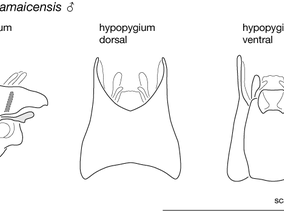You are here
Leptogastrinae
Schildia jamaicensis Farr, 1962
Nomenclature
-
Tribe: LeptogastriniGenus: Schildia
Media
SUMMARY
Head: Face silver pruinose, wide, wider than adjacent ommatidium; mystax light yellow, 2 setae; vertex wide, wider than face at clypeal–facial margin, silver pruinose; occipital triangle apruinose, distance between triangle and median eye margin more than adjacent ommatidium; occiput silver pruinose along eye margin and median dorso-ventral stripe, remaining parts grey pruinose; postocular setae light brown, long; proboscis brown.
Antennae: scape and pedicel light yellow, light yellow to light brown setae dorsally and ventrally; postpedicel light yellow proximally, light brown distally, silver pruinose, about 1.5 times as long as combined length of scape and pedicel; stylus brown, 1/5 as long as postpedicel, composed of 1 element.
Thorax: Light brown and yellow, parts silver and brown pruinose; antepronotum, postpronotum, and median postpronotal lobes silver pruinose; lateral postpronotal lobes apruinose, light yellow; scutum predominantly brown, antero-laterally yellow forming 2 thin lateral yellow stripes not reaching posterior margin, apruinose except for silver pruinose lateral and posterior margins; presutural dc setae: 1 or 2 short, 1 intermediate, 1 long, postsutural dc setae: 2 very short anteriorly oriented setae, 3 short acr setae, 1 npl and 1 spa seta; anepisternum brown with yellow dorsal margins, few yellow ane pisternal setae on anterior and dorsal margins, anteriorly and dorsally silver and remaining parts brown pruinose; anepimeron, proepimeron, katepisternum, katepimeron and meron+metanepisternum brown, proepimeron silver pruinose, katepisternum anteriorly and antero-dorsally silver pruinose, postero-dorsally brown pruinose, central area apruinose, meron+metanepisternum brown pruinose anteriorly, medially apruinose, posteriorly silver pruinose, metkatepisternum light brown, silver pruinose; scutellum brown, silver pruinose, few very short apical scutellar setae.
Legs: light yellow to light brown; coxae and trochanters light yellow; pro and mes femora light yellow with 2 transverse light brown bands, met femur mostly light brown, clubbed in distal 1/3, club brown, yellow transverse band at proximal margin of club, scattered brown macrosetae on pro and mes femora, met femur with distinct rows of brown macrosetae; pro and mes tibiae light yellow with 2 light brown transverse bands, met tibia brown with median yellow transverse band, a little more than 2 times as long as width of tibia, all tibiae with yellow to light brown erect macrosetae in rows, pro and mes tibiae with 2 long apical macrosetae, met tibia with 2 apical macrosetae, 1 median sub-distal macroseta, 4 lateral macrosetae along tibia; tarsus light yellow to light brown, proximal tarsomere always longer than 2 following tarsomeres combined, short and long macrosetae on all tarsomeres; pro and mes empodia minute, met empodium 1/4 of median claw; median claw more than half as long as lateral claw.
Wings: length = 3.2–4.6 mm; microtrichia scattered on wing, trichoid spicules short, symmetrical dorsally and ventrally, about 12–20 on M1 between r-m and diversion of M1 and M2; cell d small, terminating in M2 and M3, r-m situated proximal to separation of M3 and CuA1; R1 reaching C well proximal to R5 and M1 joining C, R2+3 straight proximally and smoothly arching posteriad distally; halter light yellow, knob dark brown, length = 0.68–0.86 mm.
Abdomen: Light yellow and brown; T2 length = 2.2–2.8 mm, T2 with yellow transverse band medially and light band sub-distally, T3–5 with yellow anterior margins, T6 entirely yellow, T2 with erect, evenly spaced macrosetae, remaining T with irregularly spaced and longer macrosetae, T7–8 with lateral sensory areas.
Male terminalia: epandrial halves fused medially; epandrium and hypandrium fused proximally; gonocoxite and hypandrium fused to form a gonocoxite-hypandrial complex; Aedeagus: not protruding from hypopygium, very short, prong dorsoventrally fl attened; Female genitalia: spermathecae occupying only segment 8, individual spermathecal ducts long and coiled; spermathecal reservoirs not sclerotized, as wide as individual ducts, forming a coil.


